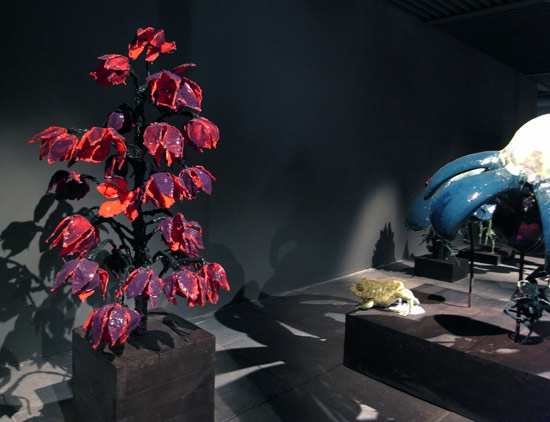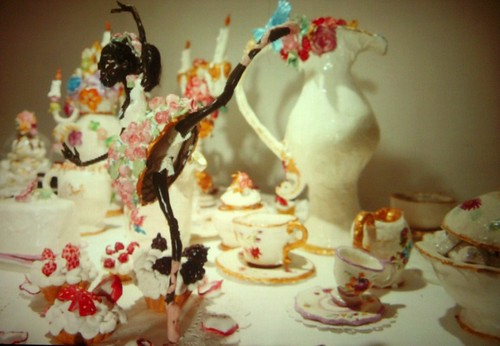Hussein Chalayan
Chalayan
is an artist and designer, working in film, dress and installation
art. Research Chalayan’s work, and then consider these questions in
some thoughtful reflective writing.
1. Chalayan’s works in clothing, like Afterwords (2000) and Burka (1996) , are often challenging to both the viewer and the wearer. What are your personal responses to these works? Are Afterwords and Burka fashion, or are they art? What is the difference?
Not all clothing is fashion, so what makes fashion fashion? (Research some definitions for these terms.)
Hussein Chalayan, Burka (1996) (99
6
I personally like the way that Hussein designed "cloth" for Muslim women. This is the obvious art work could linked to be Post-Modern Fashion. As we can see that similarity happened at both Chalayan's fashion and Aiweiwei's Han Dynasty Urn with Coca-Cola logo. They give the viewers culture shock and pluralism ideas, take advantage of the dominance of high culture by popular culture. Mixing the contrast and created a new form.
As everyone
knows the custom of Muslim is more special because women cannot
revealing too much skin in the public, bachelorette protect their face
to avoid strangers can see it. Hussein Chalayan break the rules, it is a new valuation of hybrid culture forms cancel "high/Low" categories. According to Kreis (2000) by 1990 artist start have their own mind in their art. They tried to visually represent what could not yet be given verbal expression(p.251). Artist start destroy the traditional style and have more open stage. Like Hussein used his own way to express's feeling
about what is fashion mean.
I
think Afterwords (2000) and Burka (1996) are genuine fashion because Chalayan's clothing not only
can give people eye effect, they also utility in the real word.
Afterwords(2000) was an amazing fashion because he used different
textures which was nobody else used before, metal gives the feeling more restore ancient ways combined with modern fashion girl, what a big differences and contrast shows.
What makes fashion “Fashion” is that it is more than a
visual-tactile-olfactory code or language, but that this “code” is
constantly in flux, constantly changing and almost always ambiguous.
So what makes Chalayans fashion fashion? I
think his works are often express a concept. He always keep consistent
design style and develop clothing that others don't sectors, relative to
fashion, he chose pragmatic, relative to luxury, he chose to design.
Therefore I do think his clothing can be called fashion.
2. Chalayan has strong links to industry. Pieces like The Level Tunnel (2006) and Repose
(2006) are made in collaboration with, and paid for by, commercial
business; in these cases, a vodka company and a crystal manufacturer.
How does this impact on the nature of Chalayan’s work? Does the meaning
of art change when it is used to sell products? Is it still art?
The Level Tunnel (2006)
Repose
(2006)
Chalayan
has strong links to industry. He put his wild idea associated with
business and balance up, creating market clothes which has hit the
market trend and so popular. He jump into design 3D work which really different by designing cloth, but he successful made valuable industry work and sell them a good price. As he said : My
work is about ideas. If I had to define my philosophy in just a few
words, it would be about an exploration, a journey, and storytelling –
it is a combination of these things with suggestions and proposals at
the same time.There is no limit for art so every visual thing can be defined to art, just because how special Chalayan's idea make him special.
3. Chalayan’s film Absent Presence screened at the 2005 Venice Biennale. It features the process of caring for worn clothes, and retrieving and analysing
the traces of the wearer, in the form of DNA. This work has been
influenced by many different art movements; can you think of some, and
in what ways they might have inspired Chalayan’s approach?
Hussein Chalayan, still from Absent Presence, 2005 (motion picture)
The Absent Presence is an enigmatic story based on identity, geography,
genetics, biology and anthropology. It opens the argument on how certain
identities can or cannot adapt to new environments and generates a
research based narration for Hussein's cross-disciplined installation
with filmic images and sculptures.
The ways
they might have inspired Chalayan’s approach which was his project for
venice biennale last year was a strong experience. the one before that
called place to passage, which he toured with, was a film. His
collections are always challenging and
he get
a lot out of them. all the projects have a different impact on him. He
make a real effort to push himself as far as possible with each one.
4. Many of Chalayan’s pieces are physically designed and constructed by someone else; for example, sculptor Lone Sigurdsson made some works from Chalayan’s Echoform (1999) and Before Minus Now (2000) fashion ranges. In fashion
design this is standard practice, but in art it remains unexpected.
Work by artists such as Jackson Pollock hold their value in the fact
that he personally made the painting. Contrastingly, Andy Warhol’s pop
art was largely produced in a New York collective called The Factory,
and many of his silk-screened works were produced by assistants.
Contemporarily, Damien Hirst doesn’t personally build his vitrines or
preserve the sharks himself. So when and why is it important that the
artist personally made the piece?
I think it doesn't matter when and why it is important that the artist personally made the piece, all we talk about is idea. How artist created an idea that interested audience and it become their intellectual property and is credited to them no matter how much they personally crafted. It is good for artist trying something new.
‘The Tangent
Flows’ was a concept based on his experiment, it is important that the artist personally made the
piece like Chalayan's experiment, try different materials like he said: It is part of his creative process, a method that keeps him interested in fashion design.
After his design concept have tremendous influences he success due to his full of emotions, every time he create
clothing, he does not happy only finish the standrad practice, for him
is a huge mankind step and he do the works by himself completely. For Chalayan,
fashion is an applied art in as much as it represents the employment of
an artistic sensibility to create functional objects: function over
beauty.
http://exn.tumblr.com/post/491987881/what-makes-fashion-fashion-pt-1
http://www.husseinchalayan.com/#/home/
http://www.designboom.com/eng/interview/chalayan.html
http://www.husseinchalayan.com/blog/
http://www.designboom.com/eng/interview/chalayan.html
http://www.husseinchalayan.com/blog/
http://dilsahdesigndiary.blogspot.co.nz/2010/10/review-on-hussein-chalayan.html


















